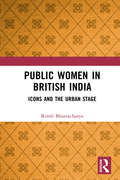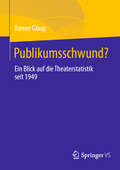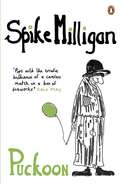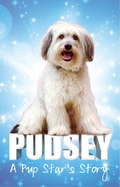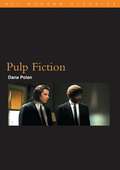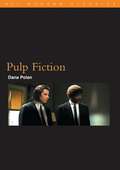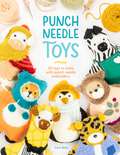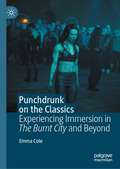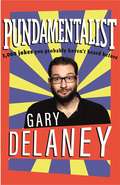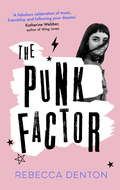- Table View
- List View
Public Women in British India: Icons and the Urban Stage
by Rimli BhattacharyaThis book foregrounds the subjectivity of ‘acting women’ amidst violent debates on femininity and education, livelihood and labour, sexuality and marriage. It looks at the emergence of the stage actress as an artist and an ideological construct at critical phases of performance practice in British India. The focus here is on Calcutta, considered the ‘second city of the Empire’ and a nodal point in global trade circuits. Each chapter offers new ways of conceptualising the actress as a professional, a colonial subject, simultaneously the other and the model of the ‘new woman’. An underlying motif is the playing out of the idea of spiritual salvation, redemption and modernity. Analysing the dynamics behind stagecraft and spectacle, the study highlights the politics of demarcation and exclusion of social roles. It presents rich archival work from diverse sources, many translated for the first time. This book makes a distinctive contribution in intertwining performance studies with literary history and art practices within a cross-cultural framework. Interdisciplinary and innovative, it will appeal to scholars and researchers in South Asian theatre and performance studies, history and gender studies.
Publikumsschwund?: Ein Blick auf die Theaterstatistik seit 1949
by Rainer GlaapDurch den teils massiven Publikumsschwund nach der Pandemie stellt sich die Frage, ob diese als Brandbeschleuniger gewirkt hat für bereits vorhandene Trends. Der Autor geht dem nach anhand der Besuchszahlen bis zur letzten vollständigen vorpandemischen Spielzeit 2018/19. Er zeigt historische Zeitreihen zu Sparten- und Personalentwicklung, Vertriebskanälen und den Einnahmen. Die Theaterstatistik des Bühnenvereins dient vielen Entscheidungsträgern als Grundlage für z.B. kulturpolitische Steuerungen, obwohl sie nicht die komplette deutsche Theaterlandschaft abbildet. Deshalb beleuchtet der Autor weitere Anbieter. Da die Theaterstatistik große kulturpolitische Bedeutung hat, gibt es zum Schluss einige Vorschläge für die Zukunft.
Publishing Networks in France in the Early Era of Print (The History of the Book)
by Diane E. BootonThis book examines commercial and personal connections in the early modern book trade in Paris and northwestern France, ca. 1450–1550. The book market, commercial trade, and geo-political ties connected the towns of Paris, Caen, Angers, Rennes, and Nantes, making this a fertile area for the transference of different fields of knowledge via book culture. Diane Booton investigates various aspects of book production (typography and illustration), market (publishers and booksellers), and ownership (buyers and annotators) and describes commercial and intellectual dissemination via established pathways, drawing on primary and archival sources.
Publishing Networks in France in the Early Era of Print (The History of the Book)
by Diane E. BootonThis book examines commercial and personal connections in the early modern book trade in Paris and northwestern France, ca. 1450–1550. The book market, commercial trade, and geo-political ties connected the towns of Paris, Caen, Angers, Rennes, and Nantes, making this a fertile area for the transference of different fields of knowledge via book culture. Diane Booton investigates various aspects of book production (typography and illustration), market (publishers and booksellers), and ownership (buyers and annotators) and describes commercial and intellectual dissemination via established pathways, drawing on primary and archival sources.
Puckoon
by Spike MilliganPuckoon is Spike Milligan's classic slapstick novel, reissued for the first time since it was published in 1963.'Pops with the erratic brilliance of a careless match in a box of fireworks' Daily MailIn 1924 the Boundary Commission is tasked with creating the new official division between Northern Ireland and the Irish Republic. Through incompetence, dereliction of duty and sheer perversity, the border ends up running through the middle of the small town of Puckoon.Houses are divided from outhouses, husbands separated from wives, bars are cut off from their patrons, churches sundered from graveyards. And in the middle of it all is poor Dan Milligan, our feckless protagonist, who is taunted and manipulated by everyone (including the sadistic author) to try and make some sense of this mess . . .'Bursts at the seams with superb comic characters involved in unbelievably likely troubles on the Irish border' Observer'Our first comic philosopher' Eddie IzzardSpike Milligan was one of the greatest and most influential comedians of the twentieth century. Born in India in 1918, he served in the Royal Artillery during WWII in North Africa and Italy. At the end of the war, he forged a career as a jazz musician, sketch-show writer and performer, before joining forces with Peter Sellers and Harry Secombe to form the legendary Goon Show. Until his death in 2002, he had success as on stage and screen and as the author of over eighty books of fiction, memoir, poetry, plays, cartoons and children's stories.
Pudsey: A Pup Star's Story
by PudseyLast year, a dog danced his way into the history books as the first canine winner of Britain's Got Talent. On their way to the title, Pudsey and his owner Ashleigh Butler won over Walliams, delighted Dixon, stole the heart of Holden, and utterly captivated Cowell. They charmed the nation, too - with millions of families tuning in to see them take the crown.As a young pup, Pudsey always knew he was somehow different to other puppies. While his brothers and sisters contented themselves with chasing their tails, he sat apart, hoping for something more. Pudsey: A Pup Star's Story tells the story of his incredible, inspirational journey, straight from the dog's mouth.
Pueblo Style and Regional Architecture (Routledge Revivals)
by Nicholas C. Markovich Wolfgang F. Preiser Fred G. SturmFew architectural styles evoke so strong a sense of place as Pueblo architecture. This book brings together experts from architecture and art, archaeology and anthropology, philosophy and history, considering Pueblo style not simply architecturally, but within its cultural, religious, economic, and climate contexts as well. The product of successive layers of Pueblo Indian, Spanish, and Anglo influences, contemporary Pueblo style is above all seen as a harmonious response to the magnificent landscape from which it emerged. Pueblo Style and Regional Architecture, first published in 1990, is a unique and thorough study of this enduring regional style, a sourcebook that will inform and inspire architects and designers, as well as fascinate those interested in the anthropology, culture, art, and history of the American Southwest.
Pueblo Style and Regional Architecture (Routledge Revivals)
by Nicholas C. Markovich Wolfgang F. Preiser Fred G. SturmFew architectural styles evoke so strong a sense of place as Pueblo architecture. This book brings together experts from architecture and art, archaeology and anthropology, philosophy and history, considering Pueblo style not simply architecturally, but within its cultural, religious, economic, and climate contexts as well. The product of successive layers of Pueblo Indian, Spanish, and Anglo influences, contemporary Pueblo style is above all seen as a harmonious response to the magnificent landscape from which it emerged. Pueblo Style and Regional Architecture, first published in 1990, is a unique and thorough study of this enduring regional style, a sourcebook that will inform and inspire architects and designers, as well as fascinate those interested in the anthropology, culture, art, and history of the American Southwest.
Puerto Rico Is in the Heart: Emigration, Labor, And Politics In The Life And Work Of Frank Espada
by E. CarvalhoSet against the backdrop of contemporary US economic history, Puerto Rico Is in the Heart examines the emigration, labor, and political experiences of documentary photographer, human rights activist, and Puerto Rican community leader Frank Espada and considers the cultural impact of neoliberal programs directed at Puerto Rico and Puerto Ricans.
Pulling Focus: Intersubjective Experience, Narrative Film, and Ethics
by Jane StadlerThe most powerful films have an afterlife. Their sensory appeal and their capacity to elicit involvement in story, character and conflict reaches beyond the screen to subtly reframe the way spectators view ethical issues and agents within the narrative, and in the world outside the cinema. Pulling Focus: Intersubjective Experience and Narrative Film questions how cinematic narratives relate to and affect ethical life. Extending Martha Nussbaum and Wayne Booth's work on moral philosophy and literature to consider cinema, Dr. Stadler shows that film spectatorship can be understood as a model for ethical attention that engages the audience in an affective relationship with characters and their values. Building on Vivian Sobchack's Address of the Eye and Carnal Thoughts, she uses a phenomenological approach to analyse ethical dimensions of film extending beyond narrative content, arguing that the camera describes experience and views screen characters with an evaluative form of perception: an ethical gaze in which spectators participate. Films discussed include Dead Man Walking, Lost Highway, Batman Begins, Nil By Mouth, and Eternal Sunshine of the Spotless Mind.
Pulp and Other Plays by Tasha Fairbanks
by Elaine Aston Gabriele GriffinFirst Published in 2004. Routledge is an imprint of Taylor & Francis, an informa company.
Pulp and Other Plays by Tasha Fairbanks
by Gabriele Griffin Elaine AstonFirst Published in 2004. Routledge is an imprint of Taylor & Francis, an informa company.
Pulp Fiction (BFI Film Classics)
by Dana PolanDana Polan sets out to unlock the style and technique of 'Pulp Fiction'. He shows how broad Tarantino's points of reference are, and analyzes the narrative accomplishment and complexity. In addition, Polan argues that macho attitudes celebrated in film are much more complex than they seem.
Pulp Fiction (BFI Film Classics)
by Dana PolanDana Polan sets out to unlock the style and technique of 'Pulp Fiction'. He shows how broad Tarantino's points of reference are, and analyzes the narrative accomplishment and complexity. In addition, Polan argues that macho attitudes celebrated in film are much more complex than they seem.
Pulp Fiction (BFI Film Classics)
by Dana PolanPulp Fiction was one of the films that defined American cinema of the 1990s, and remains one of the stand-out movies of its director Quentin Tarantino. Tarantino's style - violent, fast, funny and full of knowing pop culture references - epitomises 90s post-modernism. Pulp Fiction was a phenomenal cult success and one of the first films to generate hot debate in internet chatrooms and on fan websites.Dana Polan's compelling analysis sets out to uncover the style and technique of Pulp Fiction. He shows how broad Tarantino's points of reference are, and analyzes the film's narrative accomplishment and complexity. Where some critics dismissed Pulp Fiction for its violence and its worship of a certain brand of cool, Polan shows how the film exemplifies new kinds of engagement with cultural and social codes, such as those around racial identity. In addition, Polan argues that the film's celebration of macho attitudes is more nuanced than might first appear. In a new afterword to this new edition, Polan looks back on Pulp Fiction 30 years after its first release.
Pulp Fiction (BFI Film Classics)
by Dana PolanPulp Fiction was one of the films that defined American cinema of the 1990s, and remains one of the stand-out movies of its director Quentin Tarantino. Tarantino's style - violent, fast, funny and full of knowing pop culture references - epitomises 90s post-modernism. Pulp Fiction was a phenomenal cult success and one of the first films to generate hot debate in internet chatrooms and on fan websites.Dana Polan's compelling analysis sets out to uncover the style and technique of Pulp Fiction. He shows how broad Tarantino's points of reference are, and analyzes the film's narrative accomplishment and complexity. Where some critics dismissed Pulp Fiction for its violence and its worship of a certain brand of cool, Polan shows how the film exemplifies new kinds of engagement with cultural and social codes, such as those around racial identity. In addition, Polan argues that the film's celebration of macho attitudes is more nuanced than might first appear. In a new afterword to this new edition, Polan looks back on Pulp Fiction 30 years after its first release.
Pumpkin Crafting
by Jen RichYour ultimate guide to carving, painting and decorating pumpkins for your home, complete with tips and recipes for getting the most out of your pumpkin all season long. From playful and whimsical pumpkins that will liven up Halloween, Day of the Dead or Thanksgiving parties to sophisticated and elegant designs that will bring autumnal charm to your home all season long, you'll find projects to suit every style and taste.Divided and organised into helpful sections, you'll find:· A guide to the tools, tips and techniques that will help you achieve the best results· Pumpkin carving projects, for transforming your pumpkins and seasonal gourds into show-stopping jack-o-lanterns· Pumpkin painting projects, for transforming your pumpkin with a lick of paint, no sharp objects required· Pumpkin dressing projects, for turning your pumpkin into an original creation with glue, tape and other odds and ends· And recipes, for using every part of the pumpkin to create delicious meals and tasty snacksEach project features easy-to-follow instructions, whilst beautiful photographs throughout will give you all the inspiration you need. And handy templates at the back of the book can be copied and used again and again for perfect results every time.
Pun: Experifigural Writings in Art&art Education (Studies in Curriculum Theory Series)
by jan jagodzinskiIn Postmodern Dilemmas: Outrageous Essays in Art&Art Education and Pun(k) Deconstruction: Experifigural Writings in Art&Art Education, jan jagodzinski presents a series of essays covering a timespan of approximately ten years. These essays chart the theory and practice of art&art education as it relates to issues of postmodernity and poststructuralism concerning representation, identity politics, consumerism, postmodern architecture, ecology, phallocentrism of the artistic canon, pluriculturalism, media and technology, and AIDS. As a former editor of The Journal of Social Theory in Art Education and a founding member for the Caucus on Social Theory in Art Education, the author attempts to deconstruct the current art education paradigm, which is largely based on modernist tenets, and to reorient art education practice to social issues as developed in both media education and cultural studies. Part of the intent in these two volumes is to undertake a sustained critique of the 1982 Art in the Mainstream (A.I.M.) statement, which continues to be considered as the core value for art education. The distinct intention of this critique is to put forward a new value base for art&art education in these postmodern times. Many of the essays raise the need to be attentive to sex/gender issues in art&art education and the need to read the artistic discourse "otherwise." There is a sustained critique of the art programs developed by the Getty Center for the Arts, whose arts curriculum presents the paradigm case of late modernist thinking. Some essays are written in a provocative form that tries to accommodate such content. This is particularly the case in Pun(k) Deconstruction, where architectural discourse is deconstructed, and which includes an "artistic performance" given by the author in 1987. This singular set of volumes combines scholarship in the areas of gender studies, aesthetics, art history, art education, poststructuralism, and cultural studies in a unique blend of theory and practice for rethinking the field of art education.
Pun: Experifigural Writings in Art&art Education (Studies in Curriculum Theory Series)
by jan jagodzinskiIn Postmodern Dilemmas: Outrageous Essays in Art&Art Education and Pun(k) Deconstruction: Experifigural Writings in Art&Art Education, jan jagodzinski presents a series of essays covering a timespan of approximately ten years. These essays chart the theory and practice of art&art education as it relates to issues of postmodernity and poststructuralism concerning representation, identity politics, consumerism, postmodern architecture, ecology, phallocentrism of the artistic canon, pluriculturalism, media and technology, and AIDS. As a former editor of The Journal of Social Theory in Art Education and a founding member for the Caucus on Social Theory in Art Education, the author attempts to deconstruct the current art education paradigm, which is largely based on modernist tenets, and to reorient art education practice to social issues as developed in both media education and cultural studies. Part of the intent in these two volumes is to undertake a sustained critique of the 1982 Art in the Mainstream (A.I.M.) statement, which continues to be considered as the core value for art education. The distinct intention of this critique is to put forward a new value base for art&art education in these postmodern times. Many of the essays raise the need to be attentive to sex/gender issues in art&art education and the need to read the artistic discourse "otherwise." There is a sustained critique of the art programs developed by the Getty Center for the Arts, whose arts curriculum presents the paradigm case of late modernist thinking. Some essays are written in a provocative form that tries to accommodate such content. This is particularly the case in Pun(k) Deconstruction, where architectural discourse is deconstructed, and which includes an "artistic performance" given by the author in 1987. This singular set of volumes combines scholarship in the areas of gender studies, aesthetics, art history, art education, poststructuralism, and cultural studies in a unique blend of theory and practice for rethinking the field of art education.
Punch Needle Toys: 20 toys to make with punch needle embroidery
by Caro BelloWelcome to Punch Needle Toys, a collection of cute and cuddly toys made using punch needle embroidery.Punch needle embroidery is a technique usually used to create homewares such as cushion covers and wall hangings, but this unique collection includes designs and instructions is for 20 adorable and original punch needle toys.These punch needle plushies are part toy, part cushion, due to the simple outline shapes. Designer and author, Caro Bello, has created a fun collection of 20 distinctive animals including Bruno the Beaver, Enrique the Elephant, and Felipe the Fox. Each of the characters has their own style and Caro uses a variety of traditional and modern punch needle stitches to create their very individual outfits.Enrique, for example, is wearing a pair of bright yellow underpants as he likes to relax while he works from home. Gaspar Giraffe is an undercover spy who wears a hidden camera beneath his bowtie and Helena Hen looks harmless in her folk-chic shawl but is actually an underground activist working for the chick rights movement.The toys are made flat and then joined and stuffed to bring them to life. There are step-by-step instructions and photography explaining how to get started with punch needle embroidery. Caro explains everything from which tools and materials to choose, through to techniques for how to do the different stitches (both traditional and modern) that are used in the projects and how to transfer the embroidery designs onto the fabric. There is also general advice about how to hold the needle correctly, choosing colours and techniques for fixing errors. Caro explains the four golden rules of needle punch embroidery to ensure that you get the best results from your stitching. And there is advice about special finishing techniques to create different looks including tufting, brushing and pompom, as well as the best techniques to sew and fill the toys when you've finished the embroidery.The toys are cleverly designed with details on the front and back and the templates have been included at full-size, so you don't need to worry about enlarging them. There is a clear 'embroidery placement' diagram for each of the toys showing which stitches are used on each animal.
The Punchdrunk Encyclopaedia
by Josephine MachonThe Punchdrunk Encyclopaedia is the definitive book on the company’s work to date, marking eighteen years of Punchdrunk’s existence. It provides the first full-scale, historical account of one of the world’s foremost immersive theatre companies, drawn from unrivalled access to the collective memory and archives of their core creative team. The playful encyclopaedic format, much like a Punchdrunk masked show, invites readers to create their own journey through the ideas, aesthetics, contexts, and practices that underpin Punchdrunk’s work. Interjections from Felix Barrett, Stephen Dobbie, Maxine Doyle, Peter Higgin, Beatrice Minns, Colin Nightingale and Livi Vaughan, among others, fill out the picture with in-depth reflections. Charting Punchdrunk’s rise from the fringe to the mainstream, this encyclopaedia records the founding principles and mission of the company, documenting its evolving creative process and operational structures. It has been compiled to be useful to scholars and students from a variety of backgrounds and disciplines, from secondary level through to doctoral research, and is intended for those with a fascination for theatre in general and immersive work in particular. Ultimately it is written for those who have dared to come play with Punchdrunk across the years. It is also offered to the curious; those adventurers ready and waiting to be immersed in Punchdrunk worlds.
The Punchdrunk Encyclopaedia
by Josephine MachonThe Punchdrunk Encyclopaedia is the definitive book on the company’s work to date, marking eighteen years of Punchdrunk’s existence. It provides the first full-scale, historical account of one of the world’s foremost immersive theatre companies, drawn from unrivalled access to the collective memory and archives of their core creative team. The playful encyclopaedic format, much like a Punchdrunk masked show, invites readers to create their own journey through the ideas, aesthetics, contexts, and practices that underpin Punchdrunk’s work. Interjections from Felix Barrett, Stephen Dobbie, Maxine Doyle, Peter Higgin, Beatrice Minns, Colin Nightingale and Livi Vaughan, among others, fill out the picture with in-depth reflections. Charting Punchdrunk’s rise from the fringe to the mainstream, this encyclopaedia records the founding principles and mission of the company, documenting its evolving creative process and operational structures. It has been compiled to be useful to scholars and students from a variety of backgrounds and disciplines, from secondary level through to doctoral research, and is intended for those with a fascination for theatre in general and immersive work in particular. Ultimately it is written for those who have dared to come play with Punchdrunk across the years. It is also offered to the curious; those adventurers ready and waiting to be immersed in Punchdrunk worlds.
Punchdrunk on the Classics: Experiencing Immersion in The Burnt City and Beyond
by Emma ColePunchdrunk on the Classics: Experiencing Immersion in The Burnt City and Beyond draws attention to Punchdrunk’s use of ancient Greek literature in their creation of immersive theatre. The book documents and analyses the effects of utilising Greek tragedy within both Punchdrunk’s creative development windows, and the company’s final staged productions. It features material stretching from The House of Oedipus (2000) right through to The Burnt City (2022-23), on which the author worked as dramaturg. Chapters include rehearsal studies, explorations of how Greek literature can shape an audience’s experience in immersive theatre, and considerations of how The Burnt City might change our understanding of the poetics of immersion in antiquity. Overall, Punchdrunk on the Classics provides an unparalleled depth of insight into an individual Punchdrunk production, and highlights the until-now overlooked significance of antiquity within Punchdrunk’s practice.
Pundamentalist: 1,000 jokes you probably haven't heard before
by Gary DelaneyGary Delaney, one-liner extraordinaire, has appeared on shows like Mock the Week and written for the likes of Jimmy Carr, Jason Manford, and James Corden. Now, for the first time, comes the first collection of his finest jokes. Featuring the likes of: Garden centres can't reopen fast enough for me, I've been living on borrowed thyme.We can't even afford a garden, so when my girlfriend bought us a trampoline I hit the roof.Sure everyone cares about straws killing dolphins now, but they've been breaking camels' backs for years.Genius is 1% inspiration and 99% perspiration, which explains why Prince Andrew is so stupid.Sad news: The British simile champion has died. We shall not see his like again.My mom doesn't trust my dad's secretary. I asked her why, and she just said 'I've seen her type before'.Today someone told me that I look good with a salt 'n' pepper beard, so I took that as a condiment.My French pen friend just said 'Le Monde', which means the world to me. Can anyone tell me what FOMO stands for? Everyone else seems to know.Actors have got Equity, Magicians have got the Magic Circle, but it's a shame ventriloquists don't have anyone to speak for them.Does anyone know if it's safe to dye your pubes? It's a bit of a grey area.And make sure you look out for Gary's next book, about Stockholm Syndrome: it starts off badly but by the end you'll really enjoy it . . .
The Punk Factor (This Beats Perfect #3)
by Rebecca Denton'THE PUNK FACTOR is a kick ass story that will grab your heart in a fierce punk rock grip and not let go. I loved it!' Jennifer Mathieu, author of MOXIESeventeen-year-old Frankie is obsessed with what everyone else is thinking. She can keep up with the chat - from feminism to tattoos - but when it comes to her own ideas, it's not so easy to hide her lack of confidence. But there is one personal obsession she can't deny - her art student drop-out ex boyfriend Doc. With the help of her best friend, Haruna, Frankie forms a punk rock girl band to attract his attention. She's got it all sorted; the Instagram page is live, the handmade posters are everywhere, and the band even has a first gig lined up (even if they are playing to a handful of retired bingo fans). But in her efforts to make the band a success and get Doc to notice her, Frankie starts to care less about what Doc thinks and more about how much she loves making very loud music. She finally feels a glimpse of who she can be, independent of anyone else. Then one day, Doc decides he is going to win her back . . . Punk is nothing without the freedom to be exactly who you want. But what if you're not sure who that is yet? Can you make your own noise when everyone else seems so much louder than you?'Punk rock is just another word for freedom' - Patti Smith
